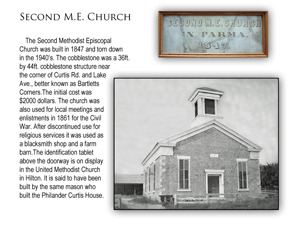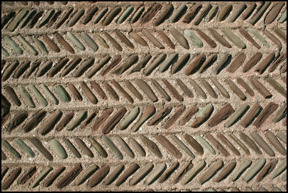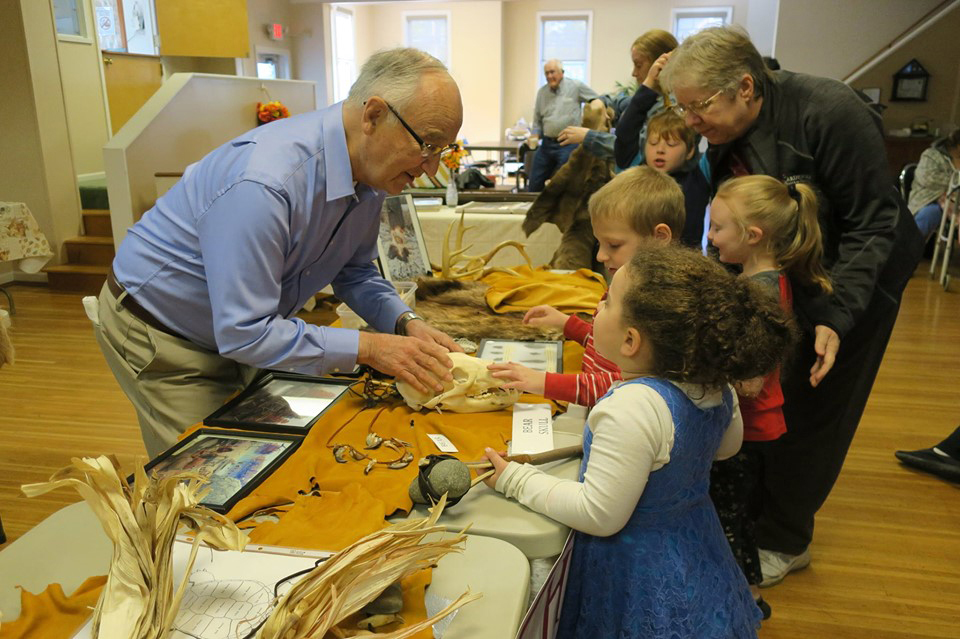Architectural treasures – The Cobblestone Buildings of Parma
 In 1825 the Erie Canal was completed. This project was one of the greatest engineering feats of all time. The canal opened up the eastern seaboard to the vast midwest territory making it possible for settlers to seek greater personal and economic opportunity.
In 1825 the Erie Canal was completed. This project was one of the greatest engineering feats of all time. The canal opened up the eastern seaboard to the vast midwest territory making it possible for settlers to seek greater personal and economic opportunity.
Many of the masons who worked on the canal buildings locks, bridges, embankments and abutments were left unemployed after the canal opened. The most skilled masons came from Ireland, England and France, and after seeing the economic boom about to take place in America were reluctant to return to their places of origin.
One way to remain in America was to find employment. A number of these masons approached affluent farmers between Syracuse and Buffalo and offered to build them cobblestone dwellings and other cobblestone buildings in return for board and room and a modest payment upon completion. Once the first of these buildings was completed their popularity increased dramatically.
Today the largest concentrated number of cobblestone buildings in America can be found between the Lake Ontario shore and the Erie Canal between Rochester and Buffalo.
The Town of Parma, founded in 1809, and located just west of Rochester in Monroe County on the shore of Lake Ontario, had twelve of these unique cobblestone buildings scattered throughout the township. One was torn down as recently as June 2012. Of the twelve original cobblestone structures nine are in existence today. They include a school house, a carriage barn, a smoke house and seven homes. The beauty, artistry, and unique character of these buildings is as impressive today as it was when they first appeared on the landscape. They have served the families who have lived in them and pleased the thousands of spectators who have passed by them over the last 165 years. Various details are included in each building. Many reflect the Greek Revival architectural style so popular in country homes and public buildings when the Republic was young.
 The round, lake-washed cobblestones mostly came from the unpopulated shoreline of Lake Ontario, and were sorted to certain specific sizes. Children were elected to help gather the stones which were free for the taking, and many wagon loads were hauled over Parma’s dirt roads in the 1830s and 1840s to become transformed into beautifully crafted buildings. Other stones came from the farmers’ fields and were of a rougher consistency.
The round, lake-washed cobblestones mostly came from the unpopulated shoreline of Lake Ontario, and were sorted to certain specific sizes. Children were elected to help gather the stones which were free for the taking, and many wagon loads were hauled over Parma’s dirt roads in the 1830s and 1840s to become transformed into beautifully crafted buildings. Other stones came from the farmers’ fields and were of a rougher consistency.
The idea of a stone house appealed to local home-owners. First no painting other than trim was required. Secondly, they were cool in the summer. Other than giving good attention to the building’s roof, little maintenance was required on the exterior. If interior plaster was applied on lath with a small space for air circulation between the stone walls, keeping them warm in the winter with coal or wood burning stoves was quite possible. With the expertise of the Erie Canal masons, the free cobblestone materials, and the economic upswing occurring in the region, the advent of these unique cobblestone structures arrived on the scene for a period of about 35 years (1825 – 1860). There are cobblestone structures between Rochester and Lewiston, NY along Ridge Road, with a concentration of them in Childs, NY, as well as in Ontario, Canada, Michigan and even Wisconsin, but those are a rarity.
To commemorate Parma’s historic cobblestone edifices, the Parma-Hilton Historical Society has created a 2013 limited edition calendar that will soon be available for sale to the public. Two hundred copies will be printed for the first edition. If those calendars are sold, another printing will be considered.
 Charles Nichols, local photographer, has carefully studied and photographed Parma’s cobblestone buildings and their fine detail. He has artistically captured the intrinsic beauty of the buildings from many angles not seen from the road. Many owners of the buildings have been interviewed and with the help of local historians the histories and backgrounds of each building have been noted for the calendar. This 2013 calendar will not only be useful for the coming year, but will become a keepsake for the future, especially for those interested in the history of Parma and Western New York Cobblestone craftsmanship.
Charles Nichols, local photographer, has carefully studied and photographed Parma’s cobblestone buildings and their fine detail. He has artistically captured the intrinsic beauty of the buildings from many angles not seen from the road. Many owners of the buildings have been interviewed and with the help of local historians the histories and backgrounds of each building have been noted for the calendar. This 2013 calendar will not only be useful for the coming year, but will become a keepsake for the future, especially for those interested in the history of Parma and Western New York Cobblestone craftsmanship.
Orders for the calendars can be placed by calling the Parma Town Hall 585-392-9461 and sending a check for $15 made out to the Parma Hilton Historical Society to confirm the order. The calendars will be available at the Hilton Apple Festival September 29 and 30. They may also be picked up at the Parma Town Hall, 1300 Hilton Parma Corners Road.





